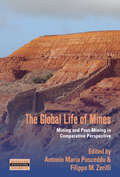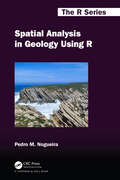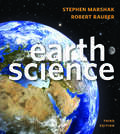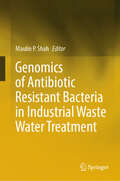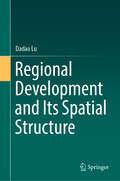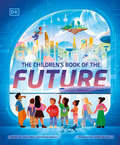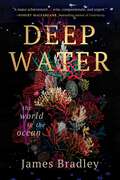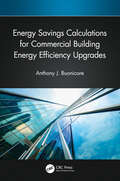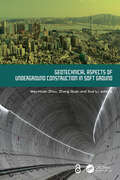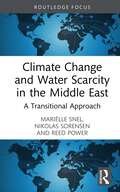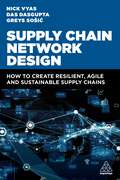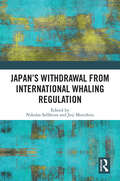- Table View
- List View
The Global Life of Mines: Mining and Post-Mining in Comparative Perspective (Dislocations #37)
by Antonio Maria Pusceddu Filippo M. ZerilliResource extraction exists in diverse settings across the world and is carried out through different practices. The Global Life of Mines provides a comprehensive framework examining the spatial and temporal relationships between mining and postmining as interrelated and coexisting features within the global minescape. The book brings together scholars from various fields, such as anthropology, geography, sociology and political science, examining ethnographic case studies throughout the Americas (Bolivia, Brazil, Peru, USA), Africa (Democratic Republic of Congo) and Europe (Italy, Arctic Norway and Spain).
Environmental Economics and Natural Resource Management
by David A. AndersonThe tools of environmental economics guide policymakers as they weigh development against nature, present against future, and certain benefits against uncertain consequences. The policies and research findings explained in this textbook are relevant to decisions made daily by individuals, firms, and governments. This textbook offers instructors and students a user-friendly, relevant, and up-to-date introduction to these topics while covering recent advancements in the field and significant political and economic changes.The book has been thoroughly updated while retaining the story-based narratives and visual emphasis of previous editions, capturing students’ attention with full-color photos, graphs, and illustrations. This sixth edition includes: Updated coverage of international environmental regulations, the effects of the COVID-19 pandemic on the environment, the effects of war on the environment, recent environmental summits and agreements, the evolving energy and transportation sectors, and trailblazing policies and research Expanded coverage of environmental issues and approaches in underrepresented countries and continents New discussions of EV batteries, populist leaders, carbon leakage, food waste, and ecological resilience Revised digital supplements, including a solutions guide, PowerPoints, and sample tests. Environmental Economics and Natural Resource Management promotes environmental and economic literacy with policy-oriented, application-based content delivered in concise, accessible discussions. Through its engaging approach, the text brings the economic way of thinking into discussions of personal, community, corporate, and government activities that affect environmental assets and the quality of life.
Spatial Analysis in Geology Using R (Chapman & Hall/CRC The R Series)
by Pedro M. NogueiraThe integration of geology with data science disciplines, such as spatial statistics, remote sensing, and geographic information systems (GIS), has given rise to a shift in many natural sciences schools, pushing the boundaries of knowledge and enabling new discoveries in geological processes and earth systems. Spatial analysis of geological data can be used to identify patterns and trends in data, to map spatial relationships, and to model spatial processes. R is a consolidated and yet growing statistical programming language with increasing value in spatial analysis often replacing, with advantage, GIS tools. By providing a comprehensive guide for geologists to harness the power of spatial analysis in R, Spatial Analysis in Geology Using R serves as a tool in addressing real-world problems, such as natural resource management, environmental conservation, and hazard prediction and mitigation.Features: Provides a practical and accessible overview of spatial analysis in geology using R Organised in three independent and complementary parts: Introduction to R, Spatial Analysis with R, and Spatial Statistics and Modelling Applied approach with many detailed examples and case studies using real geological data Presents a collection of R packages that are useful in many geological situations Does not assume any prior knowledge of R; all code are explained in detail Supplemented by a website with all data, code, and examples Spatial Analysis in Geology Using R will be useful to any geological researcher who has acquired basic spatial analysis skills, often using GIS, and is interested in deepening those skills through the use of R. It could be used as a reference by applied researchers and analysts in public, private, or third-sector industries. It could also be used to teach a course on the topic to graduate students or for self-study.
Earth Science (Third Edition): The Earth, The Atmosphere, And Space
by Stephen Marshak Robert RauberIntroducing the exciting science of earth systems Leading authors in their respective fields, Stephen Marshak (physical geology) and Robert Rauber (atmospheric science) bring decades of teaching and research experience to this remarkable textbook and media package.?Earth Science, Third Edition, connects today’s learners with the science of earth systems. Accessible explanations, extraordinary visuals, and rich, versatile media resources help students appreciate how earth science matters in their lives, communities, and careers.
Genomics of Antibiotic Resistant Bacteria in Industrial Waste Water Treatment
by Maulin P. ShahThis book discusses the key problems and solutions with various applicable approaches to combat antibiotic-resistant genes in industrial waste water. Several genes are selected within the chapters to illustrate the past and future roles of molecular ecophysiology and genomics in the development of wastewater microbiology as an important subdiscipline of microbial ecology. As we have very limited knowledge of composition, dynamics and stability of microbial communities, various processes in wastewater treatment have been generally considered to be "black box." In recent years, with the development of several new high throughput sequencing platforms, metagenome sequencing strategies and bioinformatics toolboxes, the analysis of the genome of complex communities has become much more accessible and means easier.The opening of the biological wastewater treatment “black box” is not the unpleasant experience it was before. The viable, but not cultural, ceases to be the inconsequential, uncharacterizable enigma that existed today. Metagenomics leads the way for more specific studies in related fields. Finally, genomic studies of wastewater treatment microbes, in addition to their biotechnological applications, are also an excellent testing ground for variety of other ecological and environmental burns questions. Wastewater treatment plants are considered hotspots for the environmental dissemination of antimicrobial-resistant determinants. Comparative genomics of antibiotic resistant genes isolated from conventional activated sludge and biological aerated filter wastewater treatment plants is discussed.
Livable Cities: Urban Heat Islands Mitigation for Climate Change Adaptation Through Urban Greening
by Antonella Trombadore Mohsen Aboulnaga Mona Mostafa Ahmed AbouaianaLivable Cities: Urban Heat Islands Mitigation for Climate Change Adaptation Through Urban Greening elucidates on livability in urban areas, providing readers with definitions and indicators of what makes a city livable. It comprehensively introduces the urban heat island effect (UHIE) and offers strategies for mitigating high surface temperatures in metropolitan areas and adapting to climate change (CC). The coverage highlights the linkage between UHIE and Sustainable Development Goals (SDGs), the socio-economic impacts of urban heat islands (UHIs), their effect on livability for citizens, and the costs and benefits of mitigating UHI. In addition, it encompasses background information about the problems and challenges that megacities face in the 21st century, followed by the cooling benefits that can be achieved from the different types of urban green coverage (UGC), whether conventional or innovative. The book presents case studies on six cities that have successfully applied UGC: Chicago (United States), Curitiba (Brazil), Stuttgart (Germany), Tokyo (Asia), Melbourne (Australia), and Johannesburg (South Africa). Additional case studies illustrate UHIE mapping in greater Cairo, Egypt, and Rome, Italy, to determine hot spot areas that need interventions and prioritization of UGC. Highlights also include the role of blue and green infrastructures in creating livable cities in the post-COVID-19 world, trends of bi-correlation between urban green spaces (UGSs), UGC, and COVID-19, and global patterns of UGSs to shape better healthy, sustainable, and resilient cities. Explains urban heat islands, their causes, and strategies for climate change adaptation to create livable cities; Highlights the role of urban green coverage in post-COVID-19 regulations in shaping more livable, sustainable, and resilient cities.Explores ways to reduce the urban heat island effect by exploiting urban greening to mitigate high temperatures in large cities like Cairo and Rome.
Regional Development and Its Spatial Structure
by Dadao LuThis book describes the progress and prominent theories of regional development research in the past decades, especially in the past decade, discusses the industrial structure, spatial structure, resources, and environment, as well as a series of practical issues, and reveals the general characteristics of spatial structure evolution in the process of regional development. The research on the issues of regional development has become the frontier of relevant disciplines since the 1950s, and much progress has been made in the process of solving practical problems in social and economic development. This book provides an in-depth and systematic demonstration of the "point-axis system" theory of regional exploitation and development as well as the T-shaped structure of China's regional economic action in theory and practice and discusses the impact of location differential rent, restricted accessibility, technological innovation, etc., on regional development theoretically. This book is used as a reference for planning, scientific research, and teaching personnel in territorial expansion, regional economy, human geography, etc.
The Children's Book of the Future
by Lavie Tidhar Richard WatsonA Children's Book of the Future is a narrative nonfiction book that will offer an inclusive and hopeful vision of the future, with a diverse, multicultural approach that will appeal to children of all backgrounds and further appeal to the foreign market audience.The book will consist of approximately eighteen chapters that each take inspiration from current scientific research. They'll present engaging, optimistic futures that could result from the real-world science, with insets delving into how that science works. The book will be highly illustrated throughout to make complex ideas more accessible, as well as to better depict the wondrous futures that could be ahead. There will also be a preface, afterword and an activities section.Some of the diverse visions explored include underwater cities; the solar system and space travel; green technologies and sustainability; robots and artificial intelligence; the future of cities; and much more!In short, the book sets out to reclaim the future for current and future generations of children.
Deep Water: The World in the Ocean
by James Bradley"Deep Water is a major achievement....Bradley's skills both as novelist and essayist converge here to create this wise, compassionate and urgent book, characterized throughout by a clarity of prose and a bracing moral gaze that searches water, self and reader." —ROBERT MACFARLANE, bestselling author of UnderlandIn this thrilling work—a blend of history, science, nature writing, and environmentalism—acclaimed writer James Bradley plunges into the unknown to explore the deepest recesses of the natural world.Seventy-one percent of the earth’s surface is ocean. These waters created, shaped, and continue to sustain not just human life, but all life on Planet Earth, and perhaps beyond it. They serve as the stage for our cultural history—driving human development from evolution through exploration, colonialism, and the modern era of global leisure and trade. They are also the harbingers of the future—much of life on Earth cannot survive if sea levels are too low or too high, temperatures too cold or too warm. Our oceans are vast spaces of immense wonder and beauty, and our relationship to them is innate and awe inspired.Deep Water is both a lyrically written personal meditation and an intriguing wide-ranging reported epic that reckons with our complex connection to the seas. It is a story shaped by tidal movements and deep currents, lit by the insights of philosophers, scientists, artists and other great minds. Bradley takes readers from the atomic creation of the oceans, to the wonders within, such as fish migrations guided by electromagnetic sensing. He describes the impacts of human population shifts by boat and speaks directly and uncompromisingly to the environmental catastrophe that is already impacting our lives. It is also a celebration of the ocean’s glories and the extraordinary efforts of the scientists and researchers who are unlocking its secrets. These myriad strands are woven together into a tapestry of life that captures not only our relationship with the planet, but our past, and perhaps most importantly, what lies ahead for us.A brilliant blend of Robert MacFarlane’s Underland, Susan Casey’s The Underworld, and Simon Winchester’s Pacific and The Atlantic, Deep Water taps into the essence of our planet and who we are.
Ray's Big Day: A Journey at the Speed of Light
by Josh LewisFollow one little ray of light as she embarks on an exciting journey through the solar system and beyond!When Ray launches from the sun into outer space, she knows she's destined for adventure. But who knew everything in space was so far apart? Can Ray unlock her creativity to pass the time and make something new?With a lovable protagonist and engaging comic illustrations, Ray's Big Day tackles the vastness of space through one ray of light's optimistic exploration. Ray's journey makes basic information about the solar system, the universe, and the speed of light accessible and engaging for kids. Fun and educational backmatter illustrates how far and fast light travels through our solar system.Perfect for readers of Stacy McAnulty's Earth! My First 4.54 Billion Years.
Energy Savings Calculations for Commercial Building Energy Efficiency Upgrades
by Anthony J. BuonicoreCode-compliant building materials and equipment will typically have a lower initial cost; however, the lifetime energy savings of the high efficiency equipment will often justify the upfront cost premium and result in a more cost-effective solution. Energy Savings Calculations for Commercial Building Energy Efficiency Upgrades assists energy professionals, contractors, building owners, and managers in developing energy savings estimates that can facilitate a quick assessment of the potential energy savings that might be realized when replacing existing building components with the highest efficiency equipment. It also provides algorithms to estimate greenhouse gas emission reductions that may be achieved by building energy efficiency upgrades and the impact these upgrades can have on building electrification-decarbonization projects. This book: Focuses on the development of energy savings estimates based upon a whole building’s energy consumption and the energy consumption associated with building end-uses such as space heating, space cooling, ventilation, lighting, and so forth. Includes over 70 illustrative examples using algorithms to demonstrate how energy savings and greenhouse gas emission reductions may be estimated utilizing different strategies and equipment.
Geotechnical Aspects of Underground Construction in Soft Ground
by Wan-Huan ZhouGEOTECHNICAL ASPECTS OF UNDERGROUND CONSTRUCTION IN SOFT GROUND comprises a collection of 68 contributions, including 55 technical papers, 6 General Reports, 5 Keynotes, 1 Fujita Lecture, and 1 Bright Spark Lecture presented at the 11th International Symposium on Geotechnical Aspects of Underground Construction in Soft Ground (IS-Macau 2024), held in Macao SAR, China, on June 14-17, 2024.The symposium is the latest in a series that began in New Delhi in 1994 and was followed by symposia in London (1996), Tokyo (1999), Toulouse (2002), Amsterdam (2005), Shanghai (2008), Rome (2011), Seoul (2014), Sao Paulo (2017), and Cambridge (2022). This symposium was organized by the University of Macau, Civil Engineering Laboratory of Macau, and the Macau Association for Geotechnical Engineering under the auspices of TC204 of ISSMGE. The book includes contributions from more than 15 countries on the research, design, and construction of underground works in soft ground. The theme of IS-Macau 2024 is “Tunnelling and Underground Construction for Smart Cities”. The contributions cover the following topics: Basic properties and soil improvement in soft ground Constitutive and Numerical Modelling Innovative analysis and design in tunneling and underground construction Smart monitoring and visualization technologies for tunneling and underground construction Sustainability and resilience of underground infrastructure Field case studies Similar to previous editions, GEOTECHNICAL ASPECTS OF UNDERGROUND CONSTRUCTION IN SOFT GROUND serves as an invaluable resource offering insights into the contemporary methods of analyzing, designing, and executing tunnels and deep excavations within soft ground environments, crucial for the advancement of smart cities. The book is particularly aimed at academics and professionals interested in geotechnical and underground engineering.
Climate Change and Water Scarcity in the Middle East: A Transitional Approach (Earthscan Studies in Water Resource Management)
by Mariëlle Snel Nikolas Sorensen Reed PowerAs water's significance as a geopolitical resource is poised to surpass that of oil, this book explores the adaptation of Water, Sanitation, and Hygiene (WASH) services in the Middle East to climate change challenges, leveraging the Humanitarian-Development-Peace nexus for a sustainable transition and resilient solutions. Delving into the humanitarian and development sectors across the region, the authors advocate for a transformative approach towards more innovative, integrated, and localized programming. It draws a parallel between the increasing global shift in humanitarian needs, as starkly revealed by the COVID-19 pandemic, and the ongoing devastation wrought by climate change, particularly through water-related crises such as flooding, drought, famine, and conflict. The authors stress the urgent need for adaptive and sustainable strategies that can swiftly respond to evolving climate challenges. This book argues that there is currently a window of opportunity for WASH practitioners to develop broader, multi-sectoral experiences to meet these challenges. Drawing on discussions with humanitarian and development practitioners and new contemporary case studies, this book analyzes the financial, institutional, environmental, technical, and socio-cultural considerations for creating sustainable WASH services in transition. The narrative emphasizes the urgent need for a Humanitarian-Development-Peace nexus approach, advocating for multisectoral collaboration and localization as vital to addressing protracted crises and climate change's escalating threats. It calls for a strategic shift towards organizations that merge immediate humanitarian aid with sustainable development, enhancing local capacities for effective, enduring solutions. The authors conclude by outlining practical actions for humanitarian and development organizations at the local, national, regional, and global levels to support effective integrated and transitional WASH programming in the future.
Supply Chain Network Design: How to Create Resilient, Agile and Sustainable Supply Chains
by Nick Vyas Dr Das Dasgupta Professor Greys SošicThe traditional linear supply chain is no longer fit for purpose, and organizations must redesign their supply chains to become more customer-driven, agile, resilient and sustainable.Supply Chain Network Design shows how to design intelligent, agile supply chain networks in the age of geopolitical disruptions, fast-paced technological innovation and drive for more sustainable business. It outlines how to incorporate international relations and a global perspective into supply chain planning and actions and how to embed ESG and circular economy goals. It surveys the rapidly evolving technology landscape and how it impacts some companies and provides a competitive advantage to others. It also explores how to harness technologies such as robotic process automation, AI and machine-driven intelligence and the evolution of forecasting to demand sensing to enhance network design.Taking a global perspective, Supply Chain Network Design is supported by practical cases and examples and provides a consumer-driven lens that will help organizations evolve their networks from a traditional B2B to a B2B2C workflow. Covering both lessons learned and how to move forward, this will be an must-read for supply chain, logistics and distribution leaders, managers and analysts.
Japan's Withdrawal from International Whaling Regulation (Routledge Studies in Conservation and the Environment)
by Nikolas Sellheim Joji MorishitaThis book examines the impact and implications of Japan’s withdrawal from the International Convention for the Regulation of Whaling (ICRW), which came into effect in July 2019. In 1982 the International Whaling Commission (IWC) adopted a moratorium on commercial whaling which has been in effect ever since, despite the resistance of some countries, first and foremost Japan, Norway and Iceland, that engage in commercial whaling. As one of the key contributors to scientific research and funding, Japan’s withdrawal has the potential to have wide-ranging implications and this volume examines the impact of Japan’s withdrawal on the IWC itself, on the governance of whaling, and on indigenous and coastal whaling. It provides backgrounds and commentaries on this decision as well as normative and legal discussions on matters relating to sustainable use of resources, and philosophies surrounding whaling in different IWC countries. The consideration of other international environmental regimes, such as the Convention on International Trade in Endangered Species of Wild Fauna and Flora (CITES), is also examined in order to determine the international ripple effect of Japan’s decision. The book reveals that this is not just a matter of whaling but one which has significant legal, managerial and cultural implications. Drawing on deep analyses of IWC structures, the book addresses core philosophies underlying the whaling debate and in how far these may influence environmental governance in the future. This book will be of great interest to students and scholars of environmental law and governance, biodiversity conservation and sustainable development, as well as policymakers involved in international environmental and conservation agreements.
